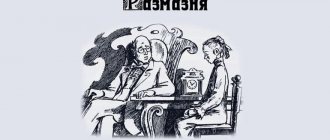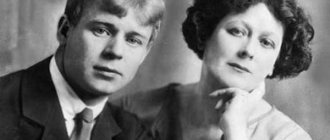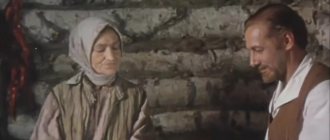- Essays
- Literature
- Chekhov
/
/
The theme of love in Anton Chekhov's stories is revealed in many ways. The author has works in which love is shown as a bright feeling, the characters in love are young and naive, they feel such emotions for the first time and do not know that not every novel can have a happy ending. Sometimes the author does not show a mature, full-fledged feeling, but only nascent love. An example of this is the story “Joke”.
Its plot, as is usually the case with Chekhov, is very simple: in winter, a young man and a girl, Nadya, ride down the mountain on a sleigh. Every time they rush down, the hero barely audibly says: “I love you, Nadenka,” but the phrase is drowned out by the roar of the wind and the creaking of snow. The heroine believes and does not believe that she hears this declaration of love in reality, she is timid to ask her companion if he uttered this phrase... Curiosity and emotional trepidation makes the girl roll down the mountain again and again to hear these words again.
The author depicts in every detail the emotional state of the characters; they are literally inspired by what is happening. The hero himself does not understand why he says these words, but an unknown force forces him to confess his love to Nadenka again and again while descending from the mountain while the wind whistles. Their love is just a “joke”; there is no drama or depth in it. But for them this is real happiness in the moment here and now.
Some of Chekhov's stories reveal the theme of love as a mature and very complex feeling. The story “The Lady with the Dog” describes the love story of a certain Mr. Gurov and Anna Sergeevna. Their relationship began as a holiday romance. Dmitry Dmitrievich had a reputation as a womanizer; he easily made women fall in love with him, but quickly lost interest in them. Never in his life had he become attached to any woman. For Gurov, these meetings were at first a familiar game. Anna, on the contrary, immediately fell in love with him and suffered from the fact that their relationship could only be secret, since both he and she had spouses. Chekhov shows the heroine's experiences. The most painful thing for her was the fact of cheating on her husband, because before that she was faithful to him and could not even admit the thought of another man.
Only some time after the breakup, Dmitry Dmitrievich realized that for the first time in his life he truly fell in love. Realizing his feelings, he goes to the city where Anna lives.
The story has an open ending. The truth of life is that the heroes are not destined to be in a place openly, but they cannot give up their love.
Other topics: ← Based on the work The Cherry Orchard ↑ ChekhovThe meaning of the title of the story Chameleon →
`
Popular writings
- Description essay based on the painting Blue Spring by Baksheev (grades 2, 3, 8)
Each season is a mystery, a source of inspiration for representatives of different types of art. With the help of paints and brushes, artists have the opportunity to convey an extraordinary range of colors. - Essay Where does my mother work
? My mother is a teacher, she works in a regular school, where I also study. I think that this profession is one of the most needed in society. Let's look at this statement with examples. - My favorite poet and writer Lermontov - essay
Each of us has our own favorite writer, poet. I really like the work of Mikhail Yuryevich Lermontov. I became acquainted with his works not so long ago, and they left a certain mark on my soul.
One of the most important themes, a theme that has a long history in literature, is the theme of love, the theme of the relationship between a man and a woman.
Love is too complex, heterogeneous, many-sided phenomenon, feeling, phenomenon of the human soul. The theme of love is an eternal theme. Each era, each person develops his own concept of love, his own understanding of this feeling.
Interest in the topic of love was great in any era. It is especially aggravated in times of crisis, when the feeling of insecurity, vulnerability, and worthlessness of one’s own “I” is dominant for most people. Chekhov has his own understanding and attitude to this issue. In his notebook he wrote: “Love is either a remnant of something degenerating that was once huge, or it is part of something that in the future will develop into something huge, but in the present it does not satisfy, it gives much less than you expect.” "
Love in Chekhov's life is a topic that is unlikely to ever be fully explored, described, or commented on. Chekhov will remain an eternal mystery for us. You can try to answer the question, who did Chekhov really love: Mizinova, Avilova, Knipper? What place did Efros and Yavorskaya occupy in his heart? Did he love anyone at all or was, in the opinion of Lika Mizinova, “sour” and not “a living person - a man!”, a person with “cold blood,” as the critic N. K. Mikhailovsky wrote about him in an article about the collection Chekhov's stories "Gloomy People"? But these reflections are unlikely to lead us to an understanding of the writer’s work. Let us just refer to the opinion of Lev Shestov, who believed that there is no surer way to “find out” than to rely on Chekhov’s works and on one’s own guess.
The only fact that I would like to cite when talking about the image of Chekhov the man is the opinions of Merezhkovsky and Shestov, who represent a kind of generalized image-impression or image-symbol of the Russian writer, obtained through the prism of their perception. Merezhkovsky notices such a “strange” feature of Chekhov as the fact that he was always “of the same age, indefinite, middle.” He never seemed young to him and, accordingly, could not grow old.
Shestov draws attention to the fact that “Chekhov always walks hunched over, hanging his head and never turns his gaze to heaven, because there are no signs for him there.”
Of course, these small touches to the portrait of Chekhov carry a certain symbolic load and are distinguished by a degree of conventionality, but then, what a work of literature consists of is also essentially conventional.
The theme of the relationship between a man and a woman in the writer’s work occupies one of the significant (if not the main) places. More than forty works (short stories, novellas, dramas) describe a mosaic of destinies, characters, situations associated with the feeling of love, which can take on such different, sometimes the most contradictory and even mutually exclusive guises (which, in principle, does not contradict human nature), which comes to mind the legend of Leonardo da Vinci, who painted Christ and Judas from the same person.
Subtle, poetic love, permeating the entire artistic space of the work with purity, sincerity, and a special musicality of the atmosphere, is felt in the stories “House with a Mezzanine,” “Vera,” “Lady with a Dog,” “About Love.” Love, degenerated into boredom, succumbing to the corrupting effects of everyday life, vulgarity - in “The Boredom of Life”, “The Spouse”, “Duel”. Love as a way of manipulating one person with another, when the strong side, which itself does not experience deep feelings, uses another, dependent on it, precisely because that one loves deeply and seriously (from the point of view of the hero’s self-perception), we see in the stories “Volodya the Big and Little Volodya”, “Ariadne”, “Joke”, “The Story of an Unknown Man”. Love as an unrealized possibility of happiness for the heroes, the opportunity to penetrate into a different living space in which a change of roles to more successful, attractive ones is possible, finds its embodiment in the stories “On the Way”, “With Friends”, “About Love”, in the play “ The Cherry Orchard" (relationship between Lopakhin and Varya). The foreshadowing of a new, happy life, in which the significant role of love is discerned, and the peculiar situation of leaving ordinary life for a world still vaguely outlined in dreams, were realized in the stories “The Bride” and “In the Native Corner”.
Pages: 1
He pulled out a revolver and shot at Yesenin. (version of death) In the afternoon, on the eve of his death, Yesenin wrote a farewell poem: Goodbye, my friend, goodbye. My dear, you are in my chest. Destined parting Promises a meeting ahead. Goodbye, my friend, without a hand, without a word, Do not be sad and do not have sad eyebrows, - In this life, dying is not new, But living, of course, is not new. Yesenin conveyed this with...
Publicistic message of Ivan the Terrible to the Kirillo-Belozersky Monastery The message is addressed to the abbot of the monastery Kozma “with the brethren.” It begins humbly, pleadingly. Grozny imitates the tone of monastic epistles, beginning in florid Church Slavonic language with quotations from the Bible, with rhetorical questions and exclamations. But when Ivan gets to the heart of the matter and begins to denounce the monastery for being populous...
Literary systems and stages of development. Three stages of literary development The stages of the literary process are usually thought of as corresponding to those stages of human history that manifested themselves most clearly and completely in Western European countries and especially clearly in the Romance countries. In this regard, ancient, medieval and modern literatures with their own stages are distinguished (followed by...
The motive of rejected love in the works of A.P. Chekhov
Bibliographic description:
Gazina, K.V. The motive of rejected love in the works of A.P. Chekhov / K.V. Gazina.
— Text: immediate // Current problems of philology: materials of the I International. scientific conf. (Perm, October 2012). - Perm: Mercury, 2012. - pp. 23-26. — URL: https://moluch.ru/conf/phil/archive/28/2637/ (date of access: 09/25/2021). The creative path of A.P. Chekhov is one of the great achievements of Russian culture. Chekhov is a Russian writer in the deepest definition of this concept. Not only because of his love for Russian people and Russian nature, his preoccupation with the problems of Russian life. Chekhov brilliantly expressed in his work the most important feature of Russian progressive social thought - its concern with fundamental issues of social existence, affecting the vital interests of not only the Russian, but also every person, without distinction of his nationality and race.
Chekhov “discovered the process of internal liberation of the human personality from the slave shackles of the bourgeois system, a radical revaluation of all its seemingly unshakable values and at the same time showed man’s aspiration for a new life, which would give people unlimited opportunities for comprehensive development. Chekhov, the artist, discovered the universal human significance of this process” [4, 433]. This determines the worldwide significance of his work and makes it so close to readers.
Chekhov's popularity throughout the world is an achievement not only of prose, but also of drama. Chekhov, the playwright, went down in the history of Russian and world theater as a great humanist, a brave innovator who created, according to M. Gorky’s definition, “a new type of dramatic art.” Theaters in many countries around the world are increasingly turning to Chekhov. But when studying the work of Anton Pavlovich, we, of course, must talk about literary traditions, and first of all, the influence of A.S. Pushkin. The work of this brilliant writer influenced the development of Russian literature as a whole. We will see Pushkin's traditions in many works of the 19th century. R.G. Nazirov, in this regard, speaks of the “Onegin plot”[2, 361]
In his famous novel, Pushkin created an “original “estate plot”, organized by the opposition of St. Petersburg and the rural estate. The estate is depicted in unity with paintings of Russian nature and peasant labor. Note that the dominant plot situation in this plot is rejected love.
The motif of rejected love is vividly realized in the works of A.P. Chekhov, both in drama and in prose. Let us expand on this thesis in more detail.
The first play we will analyze is "The Seagull". This work reveals the theme of art. Here they argue furiously about the state of modern theater, about the social meaning of artistic creativity, about “new forms”, which are direct echoes of discussions about the art of the decadents. Not only that, the play, like no other dramatic work by Chekhov, is full of literary reminiscences. However, The Seagull is, of course, not an art criticism treatise. The heroes of the play are, first of all, people. Each of them has their own character, their own hobbies, their own troubles, their own love - their own life. Everyday and aesthetic problems, problems of love and creativity - “talks about literature” [1, 134] and “five pounds of love” [1, 134] are organically connected in the work and powerfully determine the complex relationships of the characters in the play. Therefore, love bursts into “The Seagull” - this is a feeling that embraces almost all the characters; it constitutes the dominant action of The Seagull. So, a lot of talk about literature is the first thing Chekhov says when talking about the content of the play. And, as always in such cases, he is extremely accurate. In fact, for the main characters of The Seagull, the problems of art are vital, vital issues. And Nina Zarechnaya, and Treplev, and Trigorin, and Arkadina - each of them has their own beliefs, their own creative path, each of them in the play represents a certain trend in the development of modern art. Hence the inevitable clash and struggle of opinions, heated discussions that flare up on stage.
Trigorin is a famous writer, his popularity is high, and he knows first-hand about creative quests. His works are always heard and translated into foreign languages. Of course, he is talented and has a good command of the craft of writing. He is hardworking, as evidenced by his “book”, in which he writes down his fleeting observations, sudden thoughts and associations.
Arkadina is also widely known. A talented, popular actress, accustomed to success, applause, enthusiastic fans, she is happy in her own way, because such a life suits her in everything; Irina lives only for herself, devotes time only to herself, despite her growing son.
Treplev has a completely different position in life and society. He is young, his soul still has only daring aspirations and Napoleonic plans. We see that he constantly affirms the idea of “new art” and does not accept modern art - the art of the Trigorins and Arkadina.
But through some catharsis it is Nina who comes to art. Because at the end of the play we see that Zarechnaya will have everything ahead, she put her life on it. Nina is a triumphant heroine. She alone is a true seagull - not shot, not killed, but continuing its brave, victorious flight. This girl was opposed to everyone - the artisan Trigorin, the narcissistic Arkadina, the bankrupt decadent Treplev. The latter finds the fulcrum of his life in his love for Nina, but the heroine rejects this feeling. There are at least two reasons for this: firstly, she still loves Trigorin, and secondly, Zarechnaya devotes her life to art, and this is her true calling - “I’m a seagull... no, not that... I’m an actress!” , “In our business is the ability to bear the cross” [5, 412].
The next play we are considering is “The Cherry Orchard.” This is Chekhov's last play and perhaps the most difficult. In general, the main reason around which the action develops is the loss of Ranevskaya’s estate, and the plot is a certain sequence of events. There is also intrigue in this work: will the garden be sold or not? But the intrigue is weakened so that the plot does not distract the reader; the play should provoke decipherment.
In this work, the motive of rejected love is clearly visible. The main characters of the situation are Lopakhin and Varya. Although everyone has been calling Varya a bride for a long time, this union has not been realized. The girl herself says: “He has so much to do, he doesn’t even notice me. Everyone is talking about our wedding, but there is nothing.” Of course, Ermolai Alekseevich is still a businessman, and we can see the psychological paradox of this image. “A man like a man” - despite his watch, his “white vest” and “yellow boots”, despite all his wealth, Lopakhin works like a man: he gets up “at five o’clock in the morning” and works “from morning to evening.”
He is in constant business fever: “we have to hurry,” “it’s time,” “time doesn’t wait,” “there’s no time to talk.” In the last act, after purchasing the cherry orchard, his business excitement turns into some kind of nervous business fever. He is no longer only in a hurry, but also in a hurry to others: “Hurry up,” “It’s time to go,” “Come out, gentlemen...”. But this is not the cornerstone of a failed marriage. The most important thing here, according to Chekhov, is the coincidence of circumstances, life itself. Even the words of this hero about his disposition towards Varya - “I’m not against it, she’s a good girl” [5, 263] - have no meaning in this situation.
The fact is that there are no one to blame, but everyone’s life is stuffy, boring, and everyone wants to escape into some other life. The situation of rejected love cannot be resolved otherwise, because such is life with its laws and ways.
Next, we will touch on the story “Ionych,” which shows “the subtlety of the psychological analysis of the mature Chekhov with the veil of the author’s assessment” [3, 12]. The main theme of the story is the spiritual degradation of the individual. It is important for Chekhov not only to recreate the process of transformation of the young, promising doctor Dmitry Startsev into the degraded, mentally devastated Ionych. The writer needs to reveal the reasons for this process. He is trying to find out what was to blame for the hero’s spiritual impoverishment.
The story of Doctor Startsev is told against the backdrop of pictures of life in the provincial town of S. Using the example of the Turkin family, Chekhov conveys the atmosphere of idleness and vulgarity that reigns in the city. As is customary, we find our heroes in precisely this state of depressing reality, which lasts endlessly, which is so familiar, and no one is looking for a way out of this routine.
The writer resorts to repetitive descriptions and details. So, at the beginning, in the middle, and at the end of the story, the writer depicts the same scenes in the Turkin family. This family is depicted as something motionless, unchanging (the only exception is, perhaps, Kotik). Doctor Startsev, unlike the Turkins, is shown in evolution, or more precisely, in the process of degradation. Characteristic in this regard are the repeated characteristics of the doctor throughout the story. At the beginning of the work, Startsev goes to the city on foot (he did not yet have his own horses). After some time, he has his own pair of horses and a coachman Panteleimon in a velvet vest. The hero thinks that “there’s no need to gain weight.” Four years later, Startsev goes to the city patients no longer in pairs, but in threes with bells. He has gained weight and weight and is reluctant to walk because he suffers from shortness of breath.
Gradually, private practice becomes the main occupation of the hero, and the passion for profit becomes the meaning of his life. The root cause of such a moral collapse is failure in love, namely, its rejection. In connection with this motive, we can emphasize the details of Onegin’s plot: the young people’s meetings take place in the garden, on a bench. The love and attention of young Startsev does not interest Ekaterina, because her dream is the stage. The cat directly indicates his reluctance to be constrained by family life - “To become a wife - no, sorry! A person should strive for a higher, brilliant goal, and family life would bind me forever” [6, 232]. And Chekhov here introduces another motive, called the motive of leaving. Katya Turkina decides to break with the surrounding philistine environment, but her attempt to leave this way of life and this life forever was not crowned with success. And, bowing his head to his family and the demands of his circle, Kotik returns to the bitter and ugly life of the provincial town of S. And such is the reality of Chekhov.
In terms of the two above motives, we will also be interested in the story “House with a Mezzanine.” But besides this, it should be noted that here Chekhov directly expresses the ideological conflict of his work - a dispute with liberal populism, its theory of “small deeds” and claims to leadership of society. In the 90s, the writer felt even more clearly the need for a radical transformation of life, which he talks about in “House with a Mezzanine.” One of the Volchaninov sisters, the “invariably strict” Lida, is a supporter of this concept. Volchaninova seems to be trying to come to the aid of the peasants, but she wants to help them in small ways, without changing the main thing - the forced, slave conditions of existence. A staunch defender of the theory of “small deeds,” she defends petty measures to combat poverty and hunger - medical centers, schools, libraries. The narrator-artist enters into a debate with this young girl, proving the inconsistency of her ideas and all her wasted efforts. “It’s easy to be a benefactor when you have two thousand dessiatines,” he says about Lida. “The people are entangled in a chain, and you do not cut this chain, but only add new links...” [6, 65].
In “The House with a Mezzanine,” the motif of rejected love is synthesized with the motif of departure, and this is reflected in the finale. Missy disappeared...Lydia told the artist that her sister and mother had gone to their aunt in the morning, and in the winter they would go abroad. A boy caught up with the artist leaving the estate and handed him a note from Zhenya. It is quite obvious that Lydia’s pedantry and contemptuous attitude towards the artist, based on it, prevailed over the manifestation of Missus’s sincere feelings. This is not cruelty, but such cruelties are found everywhere. According to Chekhov, this is life in all its manifestations, it is impossible to escape from it.
In Chekhov's short story “About Love” the motive of rejected love is also revealed. Using the example of the life of the landowner Alekhine, we see the extremes of the sad ugliness of life and man. A case complex is clearly revealed in the character of the main character. Having set himself the goal of paying his father’s debt, he quite consciously turned himself into his own hostage. This case forced him to give up a lot, ultimately from himself. Having previously naively believed that working life could be reconciled with his cultural habits, Alekhine eventually abandoned his lordly “manners,” including reading, and with all his zeal “harnessed” into a frantic rural life along with the peasants. He lived constantly in the village, worked a lot, but was penniless.
After meeting Anna Alekseevna, a wonderful light seemed to flow for Alekhine, making his existence significant and meaningful. However, Chekhov's hero abandoned his love and did not dare admit it to himself. He will do this only in the train carriage, when he will part with the woman who is leaving him forever - “When here, in the compartment, our gazes met, our spiritual strength left us both, I hugged her, she pressed her face to my chest, and tears flowed from eye; kissing her face, shoulders, hands, wet with tears - oh, how unhappy we were with her! “I confessed my love to her, and with a burning pain in my heart I realized how unnecessary, petty and how deceptive everything was that prevented us from loving” [6, 414]. But one day the path chosen by Alekhine did not let him go. True, the hero realized the stupidity of his inaction, he passes judgment on himself - this is the recognition of love as the highest spiritual good.
The motive of departure was also central to Chekhov’s last prose work, “The Bride.” The life of the heroine of the story, Nadya Shumina, is developing quite well: she is young, beautiful, and is about to get married. But gradually she begins to notice vulgarity, deception, and limitations in the little things of everyday life, in everyday life; Anxiety grows in her, and a strong desire arises to change her life. The artist Sasha’s reasoning leads her to the same thoughts. He constantly repeats that there is an idle life at home. The artist’s conversations about freedom influenced Shumina’s worldview. When there was a month left before the wedding, Nadya began to feel some kind of fear, it was hard for her. Sasha echoes the need to learn and be enlightened, pointing out that only people of this type can be of interest to society. Upon closer examination, the young girl sees all the shortcomings and vices of the society around her - for the first time she saw in her mother an ordinary unhappy woman, and in her future husband - a person disgusting to her. Even Andrei Andreevich himself positions himself in this way: “I don’t do anything and can’t do anything, I’m idle and useless... when we get married, we’ll work” [6, 414]. But Shumina decides her future fate - she goes “to freedom”, goes to study; having abandoned home, relatives, and fiancé, he breaks with his environment.
But what was previously only dreamed of by Chekhov’s heroes receives full realization in “The Bride” - the motive of insight and the motive of departure are united. It is significant that Nadya is clearly “outgrowing” Sasha (although she admits that she owes him a lot). She begins to perceive it as something outdated, old-fashioned, long sung. A new, wide, spacious, although not entirely clear, life opens up before her. The desire to break free, characteristic of many of Chekhov’s heroes, is compared in “The Bride” to joining the “Cossacks.” This comparison gives the image of the heroine undoubted depth, correlating her decision with the historical and legendary past, with the eternal aspirations of youth. Shumina says goodbye to the past, and “the triumph of the present comes: Nadya is the “bride of the future” [3, 15]. But the main character’s aspiration to the future is devoid of any specificity: it is, rather, a symbol of the very idea of a new life. For Chekhov, “the main thing was not so much where exactly his heroes want to go, but rather what they are trying to get away from” [4, 426]. The writer avoided clear and unambiguous forecasts, especially where the future seemed vague and unclear not only to his heroes, but also to himself. In “The Bride,” Nadya’s romantic dreams of a life full of secrets are shown by a more restrained comment from the author, who reported that his heroine, “lively, cheerful, left the city - as she believed, forever” [6, 440]. This “as I believed” expresses the full extent of the caution of faith in the future and the moderation of Chekhov’s optimism, who always warned readers about the difficult and complex struggle that must be waged in order for life to actually become broad and spacious.
So, having studied a small number of works by A.P. Chekhov, we can conclude that the motive of rejected love is presented in this author in many ways and is often associated with other motives.
Literature:
- Berdnikov G. Chekhov - playwright. M., 1981, p.269.
- Nazirov R.G. About mythology and literature, or Overcoming death. Ufa, 2010. p. 361.
- Nazirov R.G. The poetics of A.P. Chekhov's prose in its development. Ufa, 2002. p.15.
- Skaftymov A.P. Moral quests of Russian writers. M., 1972. p.433.
- Chekhov A.P. Collected works in 12 volumes. T.6.M., 1985, p. 439.
- Chekhov A.P. Collected works in 12 volumes. T.9.M., 1985, p. 448.






